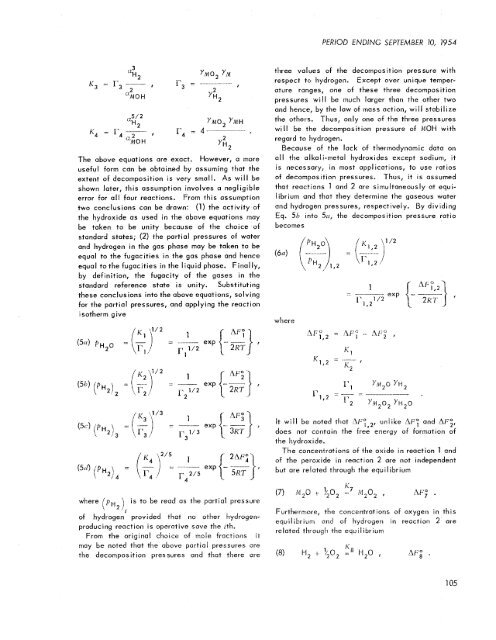ORNL-1771 - Oak Ridge National Laboratory
ORNL-1771 - Oak Ridge National Laboratory
ORNL-1771 - Oak Ridge National Laboratory
Create successful ePaper yourself
Turn your PDF publications into a flip-book with our unique Google optimized e-Paper software.
K, I r3<br />
(G2<br />
PERIOD ENDING SEPTEMBER 70, 7954<br />
YM 0 yhf<br />
three values of the decomposition pressure with<br />
respect to hydrogen. Except over unique temper-<br />
2 ature ranges, one of these three decomposition<br />
uizl Q H<br />
pressures will be much larger than the other two<br />
- I I', = - I<br />
4:<br />
d2<br />
YMO, YMMH<br />
K =r--l<br />
4 4<br />
I'4 - 4----"<br />
4 O H di<br />
The above equations are exact. However, a rrtore<br />
useful form can be obtained by assuming that the<br />
extent of decomposition is very small. As will be<br />
shown later, this assumption involves a negligible<br />
error for all four reactions. From this assumption<br />
two conclusions can be drawn: (1) the activity of<br />
the hydroxide as used in the above equations may<br />
be taken to be unity because of the choice of<br />
standard states; (2) the partial pressures of water<br />
and hydrogen in the gas phase may be taken to be<br />
equal to the fugacities in the gas phase and hence<br />
equal to the fugacities in the liquid phase. Finally,<br />
by definition, the fugacity of the gases in the<br />
standard reference state is unity. Substituting<br />
these conclusions into the above equations, solving<br />
for the partial pressures, and applying the reaction<br />
isotherm give<br />
2/5<br />
where (pH- ) is to be read as the partial presswe<br />
[ ..2Ii<br />
of hydrogen provided that no other hydrogenproducing<br />
reaction is operative save the Ith.<br />
From the original choice of mole fr~cti~ns it<br />
may be noted that the ubove partial pressures are<br />
1<br />
'<br />
and hence, by the law of mass action, will stabilize<br />
the others. Thus, Qnly one of the three pressures<br />
will be the decomposition pressure of ,llOH with<br />
regard to hydrogen.<br />
Because of the lack of thermodynamic data on<br />
all the alkali-metal hydroxides except sodium, it<br />
is necessary, in most applications, to use ratios<br />
of decomposition pressures. Thus, it IS assumed<br />
that reactior~s 1 and 2 are simultaneously at equi-<br />
librium and that they determine the gaseous water<br />
and hydrogen pressures, respectively. By dividing<br />
Eq. 56 into 5a, the decomposition pressure ratio<br />
becomes<br />
where<br />
The concentrations of the oxide in reaction 1 and<br />
of the peroxide in reaction 2 are not independent<br />
but are related through the equilibrium<br />
4"s" .<br />
Furtkrrrrore, the concentrations of oxygen in this<br />
equilibrium atid of hydrugen in reuction 2 are<br />
related through the equilibrium<br />
the decomposition pressures and that there ure (8) AF,. a



![Review of Molten Salt Reactor Physics Calculations [Disc 2]](https://img.yumpu.com/21979492/1/190x247/review-of-molten-salt-reactor-physics-calculations-disc-2.jpg?quality=85)













